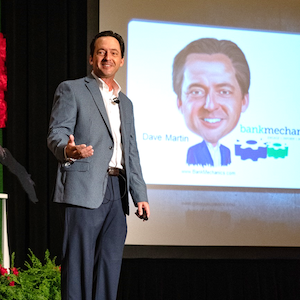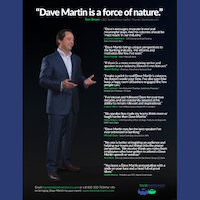 |
 |
"The moment we believe that success is determined by an ingrained level of ability as opposed to resilience and hard work, we will be brittle in the face of adversity." » Joshua Waitzkin
"Dumb Luck" Isn't Dumb
During a recent conversation with a group of young managers, one of them joked about a success she attributed to "dumb luck."
I responded with a broad smile, telling her that dumb luck might have been my most successful strategy when I managed a branch.
The group initially thought I was kidding.
I then shared with them a philosophy I often preached to the branch managers who reported to me later in my career.
I would explain that we all have smart strategies for success: make a certain number of calls, talk to a certain number of people, handle a certain number of rejections, and so forth, to find that next great prospect.
Professionals follow proven strategies. However, we all have stories about a great customer or a fantastic opportunity that seemed to fall out of the sky.
We just happened to be in the right place at the right time.
It wasn't planned—it was fortuitous.
One of my favorite lines when I first managed an in-store branch was that I'm totally okay with being dumb and lucky.
What I know is that I can be dumb anywhere.
Just point to a spot in my branch, and I can stand there and bring the dumb.
Luck, however, only seemed to happen when I stepped out into the sea of humanity on the other side of our counter.
And as much as I'd like to say it was the incredible aura of financial wisdom I displayed that drew people to me, I couldn't.
Instead, it was a smile, a "Good to see you!" or a random chat with someone who knew someone else and introduced me that made the difference.
My point was that good things tend to happen when we step out from wherever we spend most of our days—planning, managing, strategizing, or watching memes on our phones—and give "luck" an opportunity to bump into us.
Every person you meet, or acquaintance you check in with, represents an opportunity to create and leave positive impressions.
These random, positive interactions are seeds you plant that may bloom in unexpected places and ways.
Some may sprout immediately, while others emerge later, but all are possible only because you chose to step out and see what’s out there.
Thomas Jefferson was right: The harder you work, the more luck you will seem to have.
But remember to get out there—wherever your "there" is—and give luck a chance to make your acquaintance.
A Thespian's Resolve
I’ve been making joking comments to groups I address over the past year or so about my older son’s current profession.
He graduated from college with a degree in music and, among other side hustles, has become active in professional theater.
I thought the banking business was competitive until I began witnessing the theater world.
It’s a realm where talented young people are willing to put in long hours and face constant critique, usually for very modest pay.
They also continually have to apply for their next job, competing against friends.
Think about that. For most, one of the least enjoyable aspects of business is looking for a new job.
In theater, that’s your world.
You go to auditions and compete against the good friends you’ve made while working on other shows or at other casting calls.
I was home recently when my son, taking a day off from his other job, was headed to an open casting call for one of the largest theater groups in the country.
While the downtown theater district drive is one he often makes, I offered to play the role of Uber driver that day, and he accepted.
For one, I enjoy working from a laptop in public places occasionally, and I was also curious to see what the casting call looked like.
He arrived an hour before it was scheduled to begin, only to learn that there were folks who had lined up four hours earlier — we’re talking pre-dawn.
Thankfully, there was space inside for all of them — and a couple hundred very well-dressed, amazing singers and actors waited an entire day.
At around 5 PM, he called me to say they were dismissed.
About 80% of them wouldn't be seen.
One of the things that amazed me was his attitude about the whole experience. He actually enjoyed his day.
After weeks of rehearsing selected cuts from songs, putting on a suit, and spending a day in a waiting room only to be turned away, he still had a good day hanging out with talented people.
He reconnected with many actor-friends he’s come to know.
To him, it was worth his time. I laughed and told him he needs to go into business development.
We’re always auditioning for new business opportunities.
Our calls don’t always work out, and we too don’t always get seen.
But you will seldom find business you aren’t willing to enthusiastically audition for.









